Each time I visit the ruined Wuchang Temple (武昌宮) in Nantou County’s Jiji Township (集集), I ask myself the same question: Back in the 1990s, did one of the shrine’s office holders pray — or privately hope — that somehow the temple might become so famous people would flock from afar?
Like the characters in the short story The Monkey Paw, they got what they wanted, but at a tremendous cost. There was no miracle. Instead, the 921 Earthquake rendered the temple unusable and unrepairable. The disaster, which occurred in the early hours of Sept. 21, 1999, is also known as the Jiji Earthquake because the epicenter was right here.
The temple’s first floor almost entirely collapsed. The slant of the drum tower now approximates that of the Leaning Tower of Pisa. The three Taoist immortals which represent blessings, wealth and longevity, and who formerly stood at the highest point of the roof, are now face-down on the tiles, like drunks who can’t rise from the sidewalk. Only twisted rebar keeps them from sliding down to the ground, leaving these icons with no more dignity than sailors about to be keelhauled.
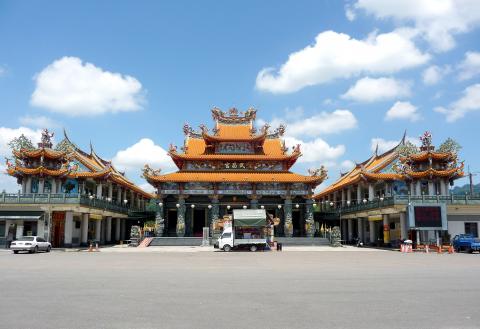
Photo: Steven Crook
Visitors can walk all the way around the ruin. At the back there’s a somewhat formal gate, secured with a shiny padlock, that looks as though it provides access to the interior. If you want to peer inside, bring a powerful flashlight.
It’s not as if the temple was struggling before the earthquake. Between 1989 and 1997, NT$70 million was spent on the construction of this hall of worship. Xuantian Shangdi (玄天上帝, Emperor of the Mysterious Heaven) and other deities have been worshiped on this site since 1903, but the temple wasn’t formally established until 20 years later, when there was a “division of incense” (分靈) from Nanyan Temple (南岩宮) in China’s Hubei Province. Some local faithful claim the beard on Wuchang Temple’s Jade Emperor (玉皇) figurine has grown since the earthquake, and continues to lengthen.
For more than a decade after the disaster, the Emperor of the Mysterious Heaven, the Jade Emperor and the temple’s other spirit effigies were housed in a tin shack across the road from the ruins. Meanwhile, tour-bus groups and individual travelers came from all over Taiwan to see and photograph the wreckage from which they were extracted. Visitors and locals made donations, and work was eventually begun on a permanent replacement.
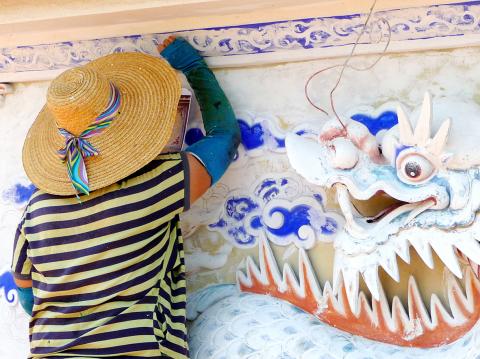
Photo: Steven Crook
The new Wuchang Temple is about twice the size, and directly in front, of the original. Inaugurated in October 2013, it’s as colorful and intricate as you’d expect. Inside, however, I haven’t spotted anything remotely innovative, and I feel that an opportunity has been missed. The Lingxiao Hall (凌霄寶殿) at Tainan’s Nankunshen Daitian Temple (南鯤鯓代天府) shows what can be achieved when a temple management committee decides to step beyond the conventional.
Even if the 21st-century Wuchang Temple is a little disappointing, the ruin behind it surely ranks as one of Taiwan’s top three “earthquake relics,” the others being Yutengping Bridge (魚藤坪斷橋) in Miaoli County’s Sanyi Township and the devastated campus of Guangfu Junior High and Elementary School (光復中小學) in Taichung. The last of these has been preserved as part of the 921 Earthquake Museum (九二一地震教育園區).
From Wuchang Temple it’s a 15-minute walk to Mingxin Academy of Classical Learning (明新書院). Established in 1878 and moved to its current location 30 years later, the academy was endowed by merchants who had made their fortunes from camphor. Local boys came here to be educated in the Chinese classics. Nowadays it functions as both a tourist attraction and a shrine dedicated to Wenchang Dijun (文昌帝君), a Taoist deity often prayed to by Taiwanese hoping for success in major examinations.
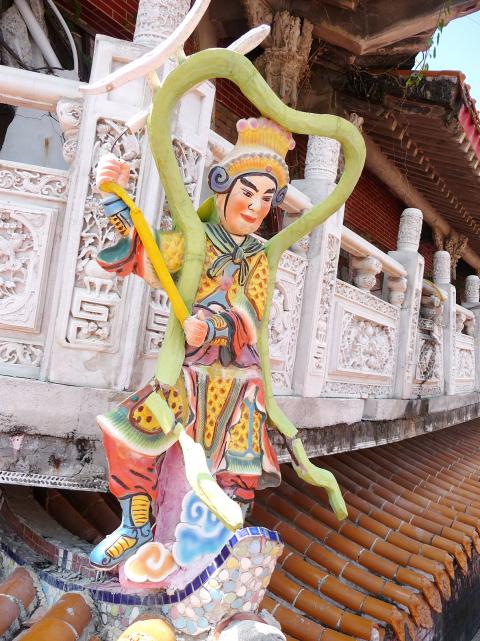
Photo: Steven Crook
From the academy you can enjoy good views of the mountains that surround Jiji, but if you’re hoping to take photos of the central structure, you might be frustrated. At the time of my visit it was shrouded in scaffolding and netting. Two young artisans were retouching paintings around the complex.
Their supervisor told me the renovation was “a small case” (indeed, I couldn’t see anything wrong with the academy apart from faded colors) and suggested I take a look at the cluster of Japanese-era dormitories near the corner of Minsheng Road and Jhongshan Street. There, preservation efforts have just started, and a great deal needs to be done. A worker putting in temporary props to shore up the buildings pointed out that much of the original woodwork has survived well because it’s hinoki (檜木, a type of cypress).
Next door to Mingxin Academy there’s a central government unit that plays a crucial role in understanding and preserving Taiwan’s biodiversity. The Endemic Species Research Institute (特有生物研究保育中心, tesrieng.tesri.gov.tw) also aims to educate the public, and the Conservation Education Center (open 9am to 4:30pm, Tuesday to Sunday, admission NT$60) does a fine job of introducing Taiwan’s endemic birds, beetles, butterflies, fish, snails, and plants.
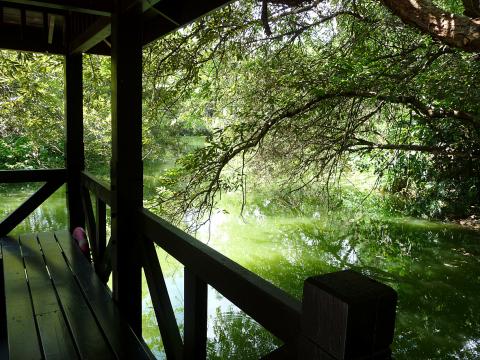
Photo: Steven Crook
If you have an interest in nature, the adjacent Ecological Education Park (open 8:30am to 4:30 daily; free admission) will enthrall you for an hour or more. During the hot season you can expect to see some gorgeous dragonflies — but make yourself mosquito-proof before entering.
Placing the institute in Jiji makes absolute sense, of course. The town is between the lowlands and the highlands. It’s near waterways and substantial forests, and it can also be a stepping stone to a number of alluring places deep in Taiwan’s interior.
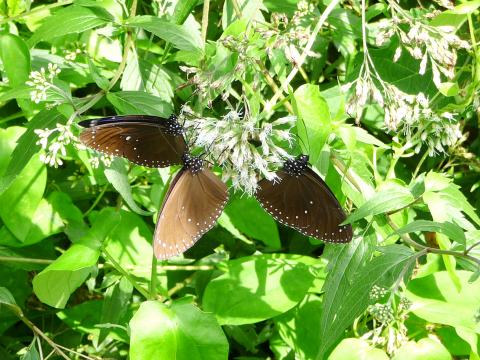
Photo: Steven Crook

This month the government ordered a one-year block of Xiaohongshu (小紅書) or Rednote, a Chinese social media platform with more than 3 million users in Taiwan. The government pointed to widespread fraud activity on the platform, along with cybersecurity failures. Officials said that they had reached out to the company and asked it to change. However, they received no response. The pro-China parties, the Chinese Nationalist Party (KMT) and Taiwan People’s Party (TPP), immediately swung into action, denouncing the ban as an attack on free speech. This “free speech” claim was then echoed by the People’s Republic of China (PRC),

Exceptions to the rule are sometimes revealing. For a brief few years, there was an emerging ideological split between the Democratic Progressive Party (DPP) and Chinese Nationalist Party (KMT) that appeared to be pushing the DPP in a direction that would be considered more liberal, and the KMT more conservative. In the previous column, “The KMT-DPP’s bureaucrat-led developmental state” (Dec. 11, page 12), we examined how Taiwan’s democratic system developed, and how both the two main parties largely accepted a similar consensus on how Taiwan should be run domestically and did not split along the left-right lines more familiar in

Many people in Taiwan first learned about universal basic income (UBI) — the idea that the government should provide regular, no-strings-attached payments to each citizen — in 2019. While seeking the Democratic nomination for the 2020 US presidential election, Andrew Yang, a politician of Taiwanese descent, said that, if elected, he’d institute a UBI of US$1,000 per month to “get the economic boot off of people’s throats, allowing them to lift their heads up, breathe, and get excited for the future.” His campaign petered out, but the concept of UBI hasn’t gone away. Throughout the industrialized world, there are fears that

Most heroes are remembered for the battles they fought. Taiwan’s Black Bat Squadron is remembered for flying into Chinese airspace 838 times between 1953 and 1967, and for the 148 men whose sacrifice bought the intelligence that kept Taiwan secure. Two-thirds of the squadron died carrying out missions most people wouldn’t learn about for another 40 years. The squadron lost 15 aircraft and 148 crew members over those 14 years, making it the deadliest unit in Taiwan’s military history by casualty rate. They flew at night, often at low altitudes, straight into some of the most heavily defended airspace in Asia.